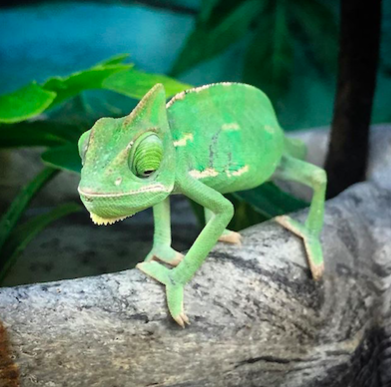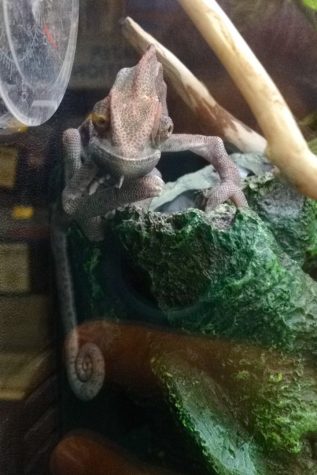Chameleon Soup and The Truth About Camouflage
How humans have totally misinterpreted chameleons throughout history

Photo courtesy of Laura Hurcomb
October 20, 2016
What animal appeared in a Disney movie, is believed to have medicinal properties when dried out, has a tongue that defies the principles of power production, and speaks through colors? (No, this isn’t the beginning of a bad joke.)
The answer? A chameleon.
The reason you should care? For one, chameleons are cool and exotic animals with a lot of interesting facets. And second, while the popularity of these wild animals as pets has increased greatly over the past few decades, the rise in the knowledge of how to properly care for these animals has only become common in the past five years.
Alien 1: Dude! Yesterday I abducted this really cool human. I named it Lucy.
Alien 2: Awesome! I’ve never heard of a human before. What kind of gas do they breath?
Alien 1: Dunno… but there was a lot of carbon dioxide in Earth’s atmosphere, so I’m gonna feed it that and see how it goes.
The bad news is that chameleons have been treated poorly throughout history. But the good news is, that’s changing now and there’s a lot you, as the average American reader, can do to make sure we continue on that path. For now, let’s walk down the path of Chameleon History.
It’s believed that the first of the Chamaeleonidae family first appeared around 60 million years ago in what is now China. The family has since diverged into 180 different species living on multiple continents. Jackson, panther, and veiled chameleons are well known species- as well as the pygmy chameleon discovered recently, which is incredibly small.
Sadly, sometime during the 60 million years the chameleon happily inhabited the planet, it found itself living next door to some creepy new neighbors: Homo sapiens.
In 1809, James. G. Jackson wrote “An Account of the Empire of Morocco” and reported that “Various medicinal effects are attributed to the flesh of the camelion [chameleon]; and many whimsical effects are attributed to fumigation with it when dried; debilitated persons have recourse to it, and it is accordingly sold in all the drug shops at Marocco [Morocco], Fas and other places…”
A 1922 study found that in Nigeria, people thought ground up chameleons mixed with herbs could help convulsions when smeared over the body, or could help ensure a healthy baby when used as an enema by pregnant women. Wearing a dried chameleon on a pregnant woman’s wrist was also supposed to help keep diseases from their baby.
On a visit to Tunisia in 2006, an article reports that slaughtering a chameleon and burying it under a new building supposedly protects against evil, and in Morocco, if a woman thinks her husband is having an affair, she may put chameleon meat in his food to cure his infidelity.
Thus, in the areas that still practice old folklore medicinal treatments, chameleons are traded at spice stalls and by herbalists for reasons most Westerners would find repulsive.
But Westerners aren’t in a good place to judge, either. People don’t understand how to care for the chameleons that have been brought to America and are sold at lots of local pet stores.

When someone someone sees a chameleon at the pet store, it’s not fair to judge them for being attracted to the creature. Chameleons are exotic. They have prehensile tails that can hold onto objects, their tongues can shoot out so fast that they defy the normal principle of power production in muscles, and for most people, one of the first things that comes to mind with the word, “chameleon” is their color changing camouflage. However, scientists actually believe that their ability to change color is linked more to communication than protection. Some species vocalize to communicate, and some use pheromones, but chameleons express their emotions through pigmentation. Color changing also occurs in response to light intensity and temperature.
With all that said, it’s easy to realize that it’s almost to a chameleon’s own detriment that they’re so fascinating, because it makes humans want to hold them and bask in their novelty.
The thing is, chameleons are easily stressed. They don’t like to be handled, being closely watched, or being subjected to loud noises. They’re not tame, they need more space than what you typically see given at a pet store, they’re not social animals, and they’re not the pet to get if someone is looking for a creature to reciprocate love and affection, or if they’re looking for pet-to-human interaction.
A chameleon owner, and for that matter, the owner of any pet, needs to be sensitive to the animal’s needs prior to their own wishes. In the chameleon world, that means don’t buy a chameleon just to play with it.
(And please, don’t feed your boyfriend chameleon if they cheat on you.)


